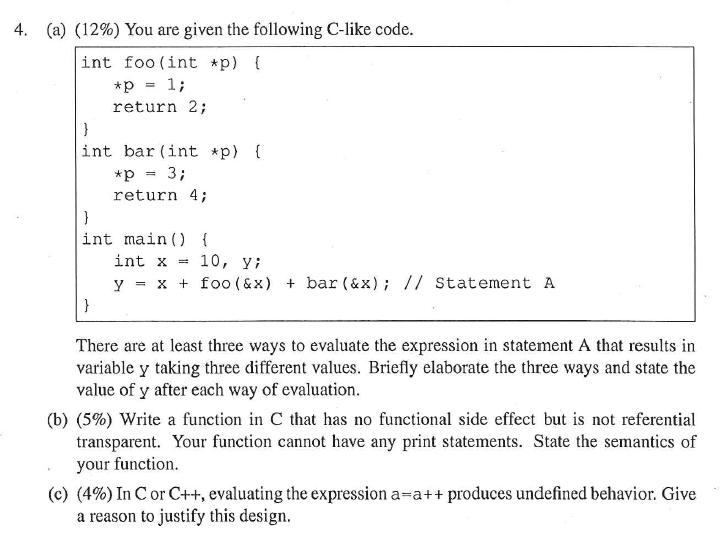Question
4. (a) (12%) You are given the following C-like code. int foo (int *p) { } *p = 1; return 2; int bar (int

4. (a) (12%) You are given the following C-like code. int foo (int *p) { } *p = 1; return 2; int bar (int *p) { } *p = 3; return 4; int main() { } int x = 10, y; y=x+foo (&x) + bar (&x); // Statement A There are at least three ways to evaluate the expression in statement A that results in variable y taking three different values. Briefly elaborate the three ways and state the value of y after each way of evaluation. (b) (5%) Write a function in C that has no functional side effect but is not referential transparent. Your function cannot have any print statements. State the semantics of your function. (c) (4%) In C or C++, evaluating the expression a=a++ produces undefined behavior. Give a reason to justify this design.
Step by Step Solution
There are 3 Steps involved in it
Step: 1

Get Instant Access to Expert-Tailored Solutions
See step-by-step solutions with expert insights and AI powered tools for academic success
Step: 2

Step: 3

Ace Your Homework with AI
Get the answers you need in no time with our AI-driven, step-by-step assistance
Get StartedRecommended Textbook for
Financial Management Theory and Practice
Authors: Eugene Brigham, Michael Ehrhardt, Jerome Gessaroli, Richard Nason
2nd Canadian edition
176517308, 978-0176517304
Students also viewed these Computer Network questions
Question
Answered: 1 week ago
Question
Answered: 1 week ago
Question
Answered: 1 week ago
Question
Answered: 1 week ago
Question
Answered: 1 week ago
Question
Answered: 1 week ago
Question
Answered: 1 week ago
Question
Answered: 1 week ago
Question
Answered: 1 week ago
Question
Answered: 1 week ago
Question
Answered: 1 week ago
Question
Answered: 1 week ago
Question
Answered: 1 week ago
Question
Answered: 1 week ago
Question
Answered: 1 week ago
Question
Answered: 1 week ago
Question
Answered: 1 week ago
Question
Answered: 1 week ago
Question
Answered: 1 week ago
Question
Answered: 1 week ago
Question
Answered: 1 week ago
Question
Answered: 1 week ago
View Answer in SolutionInn App



